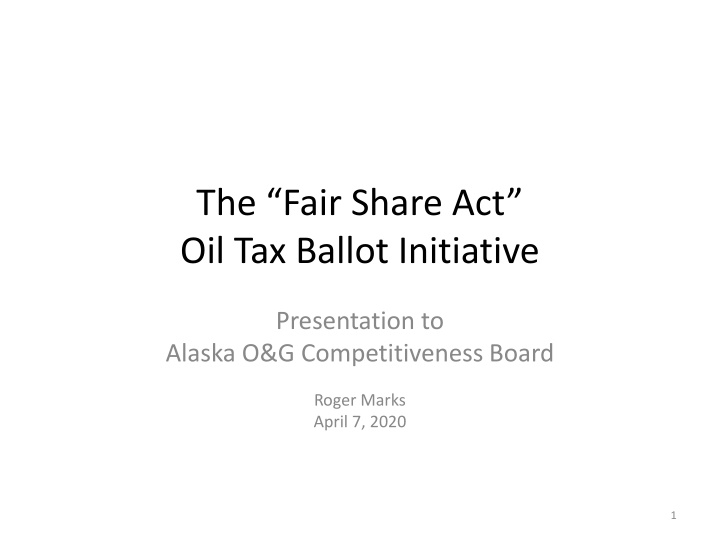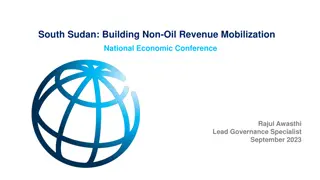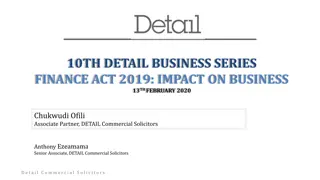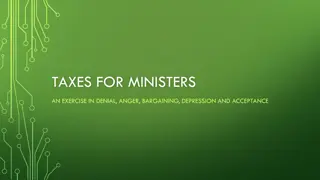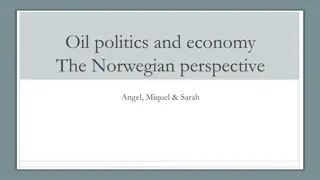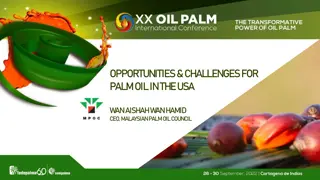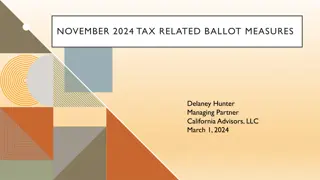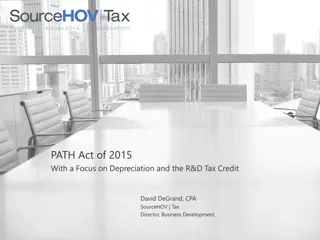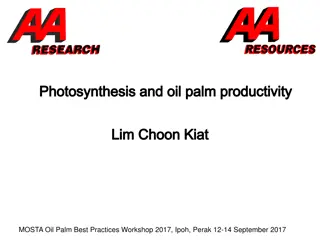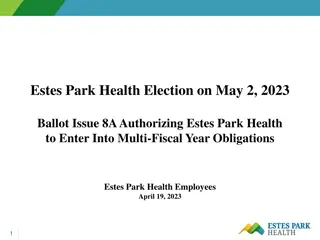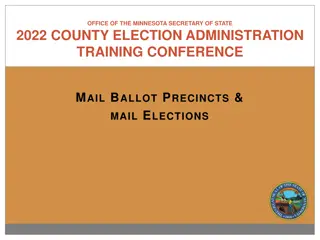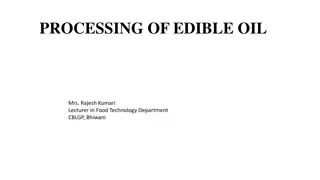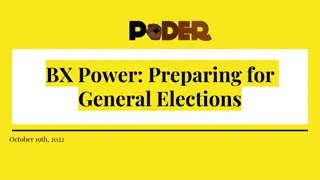Analysis of The Fair Share Act Oil Tax Ballot Initiative Presentation
The presentation discusses the proposed changes to Alaska's petroleum revenue taxes, focusing on royalties, production tax, property tax, and corporate income tax. It evaluates the impact on net income derivation, current tax versus initiative tax structures, and additional provisions like unit criteria and reporting requirements. The initiative aims to ensure a fair share for Alaskans based on historical oil revenue distribution standards.
Uploaded on Nov 20, 2024 | 1 Views
Download Presentation

Please find below an Image/Link to download the presentation.
The content on the website is provided AS IS for your information and personal use only. It may not be sold, licensed, or shared on other websites without obtaining consent from the author.If you encounter any issues during the download, it is possible that the publisher has removed the file from their server.
You are allowed to download the files provided on this website for personal or commercial use, subject to the condition that they are used lawfully. All files are the property of their respective owners.
The content on the website is provided AS IS for your information and personal use only. It may not be sold, licensed, or shared on other websites without obtaining consent from the author.
E N D
Presentation Transcript
The Fair Share Act Oil Tax Ballot Initiative Presentation to Alaska O&G Competitiveness Board Roger Marks April 7, 2020 1
State Petroleum Revenues Royalties (State ownership share) 12.5% of gross value on most North Slope leases Production (Severance) Tax This is what the initiative proposes to change Ad Valorem Property Tax 20 mills based on assessed value State Corporate Income Tax Maximum rate 9.4% of worldwide income apportioned to state (Also federal corporate income tax) 21% of income net of all other taxes & royalties 2
FY 2019 Petroleum Revenues ($millions) Royalties $1,115 Production Tax 596 Property Tax 120 State Corp Inc Tax 218 Restricted Revenues* 576 Total $2,625 * Mostly royalties to Permanent Fund and tax & royalty settlements to CBRF 3
Derivation of Net Income ANS Market Price Less Transportation Costs Gross Value ($9)* $41 $50 Net Value Less Upstream Capital & Operating Costs ($24)* $17 * Source: State DOR Fall 2019 Revenue Forecast. Upstream costs over taxable and non- taxable (royalty) barrels for fields impacted by initiative. 4
Current Tax vs Initiative Current Tax Higher of: 35% of net less per barrel credit Initiative Higher of: 35% of net per barrel credit eliminated plus progressivity of 15% of net value greater than $50 10% of gross when price less than $50, up to 15% of gross at $70 4% of gross 5
Additional Provisions of Initiative Applies to units that have produced more than 400 million barrels cumulatively, and more than 40,000 barrels a day in previous year (Prudhoe, Kuparuk, Alpine) Ring fencing of units (a company cannot offset income from one unit with losses from another) Additional reporting requirements 6
Initiative Approach to Fair Share From the Initiative Web Site One-third of the gross revenues from the sale of our oil is a good standard to apply in determining if Alaskans are getting their fair share. Governor Hammond was a key architect of our economic relationship with the oil industry. He stated the original agreement was one-third to the state, one-third to the federal government, and one-third to the producers. 7
Allocating $41 in Gross Value under Initiative State $14 (34%) Costs $24 (59%) Feds $1 (3%) Producers $2 (4%) 8
Fair Share: Competitiveness Paradigm 1960 s: State could have had its own state- owned oil company Rather, decided to open up development to the world through the competitive bidding system Development subject to market forces Jurisdictions compete with geology, costs, politics, and fiscal terms Fair share is what you can get in a competitive environment 9
Competitiveness Analysis Government take: percentage of net income that goes to government (all taxes & royalties) Issues of judgment Which peer groups? Which costs? Which metrics (mean, median, etc.)? 10
Govt Take @ $35 Oil Price (Govt take includes all state & federal taxes & royalties) Alaska - Initiative Alaska - Current North Dakota Brazil Argentina Texas New Mexico Oklahoma Colorado Norway California Gulf of Mexico Alberta UK 0% 50% 100% 150% 200% 250% 300% 350% 11
Govt Take @ $60 Oil Price (Govt take includes all state & federal taxes & royalties) Norway Alaska - Initiative Brazil North Dakota Alberta Texas Alaska - Current New Mexico Oklahoma Argentina Colorado UK California GOM 0% 10% 20% 30% 40% 50% 60% 70% 80% 12
Govt Take: Competitive Norm (Includes all state & federal taxes & royalties) (Excludes Alaska) 100% 90% 80% Govt Take 70% 60% 50% 40% $40 $50 $60 $70 $80 $90 $100 $110 $120 $130 $140 $150 Oil Price 13
Govt Take: Alaska Currently vs Competitive Norm (Govt take includes all state & federal taxes & royalties) 100% 90% 80% Govt Take 70% 60% 50% 40% $40 $50 $60 $70 $80 $90 $100 $110 $120 $130 $140 $150 Oil Price Competitive Norm (12 jurisdictions) Alaska Currently 14
Govt Take: Competitive Norm vs Alaska Currently vs "Fair Share" Initiative (Govt take: total state & federal taxes & royalties as % of pre-tax net profits) 100% 90% 80% 150% - 350% tax increase up to $75/bbl price Govt Take 70% 60% 50% 40% $40 $50 $60 $70 $80 $90 $100 $110 $120 $130 $140 $150 Oil Price Initiative Alaska Currently Competitive Norm (12 jurisdictions) 15
How Much More The State Makes Over Producers ($/bbl) $25 $20 $15 $10 $5 $- $20 $30 $40 $50 $60 $70 Oil Price ($/bbl) $80 $90 $100 $110 $120 $130 Current Initiative 16
Per Barrel Credit 35% of net rate $8/bbl up to $80 gross After that drops $1 for every $10 that gross value increases 17
Govt Take: Competitive Norm vs Alaska Currently vs Alaska Without Per BBL Credit (Govt take: total state & federal taxes & royalties as % of pre-tax net profits) 100% 90% 80% Govt Take 70% 60% 50% 40% $40 $50 $60 $70 $80 $90 $100 $110 $120 $130 $140 $150 Oil Price Alaska Currently Without Per BBL Credit Alaska Currently Competitive Norm (12 jurisdictions) 18
Design of Per Barrel Credit: Risk / Reward Symmetry Regressive systems (gross) Taxpayer assumes downside price risk / Gets upside price potential Progressive systems (net) Government assumes downside price risk / Gets upside price potential Alaska: Heads I Win / Tails You Lose Gross minimum tax at low prices (regressive) Net tax at high prices (progressive) 19
Does Not Really Function Like a Credit At low prices the gross minimum tax exceeds the net tax (less per barrel credit) At higher prices the net tax (less per barrel credit) kicks in Tax becomes progressive Same results could have been accomplished with a progressive tax table without calling it a credit 20
Other Credits Initiative sponsors have criticized that between 2015 2019 the total severance tax collected was $0 net of credits They are combining two completely distinct accounting ledgers 21
Severance Tax Revenues & Credits 2015-2019 ($millions) 2015 2016 2017 2018 2019 Total Total severance taxes paid by large North Slope producers net of per barrel credit $ 382 $ 177 $ 126 $ 741 $ 587 $ 2,013 Credits (Paid & Owed) Small North Slope Producers / Explorers Non-North Slope Total credits $ $ $ 224 404 628 $ $ $ 409 380 789 $ $ $ 255 153 408 $ $ $ 71 60 131 $ $ $ 68 38 106 $ $ $ 1,027 1,035 2,062 22
1989 ELF Change Higher taxes for big fields Short-term revenue boost Investment diverted to low tax fields Production decline Tax / revenue becomes anemic The only difference between then and now: Now can switch investment to federal acreage where state royalty much less 23
The ACES Experience (2007-2013) Very aggressive progressivity structure Coincided with run-up in prices Revenue boost (high price & high tax rate) Tax exceeded competitive norms Producers making much more everywhere else Investment dried up Production dropped 24
The 2013 Production Forecast under ACES vs Actual under SB 21 750 700 650 Production (1000's of bbls/day) 600 550 500 450 400 350 2007 2009 2011 2013 2015 2017 2019 Actual Forecasted in 2013 25
2013: Forecasted vs Actual Oil Prices $130 $120 $110 $100 Oil Price ($/bbl) $90 $80 $70 $60 $50 $40 2013 2014 2015 2016 2017 2018 2019 2020 Forecasted in 2013 Actual 26
Initiatives Negative Impact on Investment Decisions Field Size Tax Increase Less cash to invest Shifting investment to low tax fields Shifting investment to other jurisdictions 400 mmbbl limit impact on Pikka / Willow Slowing down production at CRU to get below 40,000 b/d limit Deferring expansion of Milne Pt. to keep production under 40,000 b/d limit Developing Narwhal from outside CRU rather than expanding unit Ring Fencing Fewer deductions / higher tax rate NPV viability impact on Willow / Pt Thomson expansion 27
Conclusion: Standard for Fair Share What fair share is not References to gross revenues Getting money to fill a budget gap Displaced agitation toward past credits What fair share might be Competitiveness may not be the only paradigm But experiments of varying from it have failed Whatever fair share is: Something cannot be fair to just one side Unless it is fair to both sides it is not fair 28
